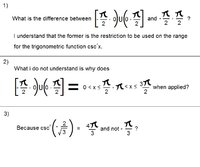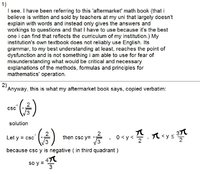Question on the restrictions on the range of inverse trigonometric functions
- Thread starter bbm25
- Start date
D
Deleted member 4993
Guest
For 1), the domain description at the left-hand-side, excludes 0 [ because cosec(0) = 1/0 which is not defined].
Dr.Peterson
Elite Member
- Joined
- Nov 12, 2017
- Messages
- 16,808
I'm not sure I understand. I think what you are really observing is that different sources define the inverse cosecant differently. It's not that the range changes when applied; it's that one person may state the range one way, and another may use a different range.
This page states that there are different conventions, and gives your range as the one they use. Something similar is stated in the note here. I haven't been able to find one that uses the second convention you refer to, though I think I've seen it somewhere.
Please tell us specifically what your sources are. Where did you get the statement of the range, and what did you use to find the answer in the example?
This page states that there are different conventions, and gives your range as the one they use. Something similar is stated in the note here. I haven't been able to find one that uses the second convention you refer to, though I think I've seen it somewhere.
Please tell us specifically what your sources are. Where did you get the statement of the range, and what did you use to find the answer in the example?
Dr.Peterson
Elite Member
- Joined
- Nov 12, 2017
- Messages
- 16,808
Clearly here they are using the unusual choice for the range, [MATH](0,\pi/2]\cup(\pi,3\pi/2][/MATH].
Are you saying that the same book previously stated the range you showed first, [MATH][-\pi/2, 0)\cup(0, \pi/2][/MATH]?
That is bad. (Their font for pi looks more Chinese than Greek, but that's forgivable ...). Either range is acceptable, as long as you are consistent. If the book isn't consistent, you'll have to ask your teachers what you are to do.
Are you saying that the same book previously stated the range you showed first, [MATH][-\pi/2, 0)\cup(0, \pi/2][/MATH]?
That is bad. (Their font for pi looks more Chinese than Greek, but that's forgivable ...). Either range is acceptable, as long as you are consistent. If the book isn't consistent, you'll have to ask your teachers what you are to do.
Steven G
Elite Member
- Joined
- Dec 30, 2014
- Messages
- 14,591
csc-1(negative number) means the angle is in quadrant 3 or 4. But wait a minute, then this means that csc-1(x) is not a function so to make it a function we restrict the domain to a continuous interval (maybe except for a single point). Someone decided that this interval is from -pi/2 to pi/2. Now the answer to you precise problem is -pi/3, but that is the same angle as 4pi/3.
Now you may say then again csc-1(x) is not a function since we get back multiple angles. This time is different as an angle in quadrant 3 is never the same angle as an angle in quad 4, but in quadrant 4 (and for the other 3 quadrants) there are multiple ways of describing the same angle.
In conclusion, the restriction you noted for csc-1(x) just tells you where the angle can be BUT does NOT tell you how to represent that angle
Now you may say then again csc-1(x) is not a function since we get back multiple angles. This time is different as an angle in quadrant 3 is never the same angle as an angle in quad 4, but in quadrant 4 (and for the other 3 quadrants) there are multiple ways of describing the same angle.
In conclusion, the restriction you noted for csc-1(x) just tells you where the angle can be BUT does NOT tell you how to represent that angle
Lol actually i drew that Pi symbol hehe. I did it because it can be confusing typing out math equations via the keyboard. For example the square root symbol √ on the keyboard doesn't have that line on top so we don't know whether √5+x covers (5+x), or just the number 5. This, and bunch of other things led me to just drawing and typing it all on Paint, including the Pi symbol (which i thought would be interesting if it looked a little unorthodox lol). Anyway thank you for your answer!
Anyway, no, actually i did not take both definitions from the same book. The first definition, i took from this PDF https://twiki.math.cornell.edu/do/v...Functions?filename=Inverse_Trig_Functions.pdf page 2. I took the second definition from my book.
Anyway, no, actually i did not take both definitions from the same book. The first definition, i took from this PDF https://twiki.math.cornell.edu/do/v...Functions?filename=Inverse_Trig_Functions.pdf page 2. I took the second definition from my book.
csc-1(negative number) means the angle is in quadrant 3 or 4. But wait a minute, then this means that csc-1(x) is not a function so to make it a function we restrict the domain to a continuous interval (maybe except for a single point). Someone decided that this interval is from -pi/2 to pi/2. Now the answer to you precise problem is -pi/3, but that is the same angle as 4pi/3.
Now you may say then again csc-1(x) is not a function since we get back multiple angles. This time is different as an angle in quadrant 3 is never the same angle as an angle in quad 4, but in quadrant 4 (and for the other 3 quadrants) there are multiple ways of describing the same angle.
In conclusion, the restriction you noted for csc-1(x) just tells you where the angle can be BUT does NOT tell you how to represent that angle
Thank you for your response.
I also thought my answer was -pi/3 but my book said 4pi/3, as stated in the initial post, which was what confused me.
But anyway, what is it that does tell me how to represent the angle then?
Dr.Peterson
Elite Member
- Joined
- Nov 12, 2017
- Messages
- 16,808
Lol actually i drew that Pi symbol hehe. I did it because it can be confusing typing out math equations via the keyboard. For example the square root symbol √ on the keyboard doesn't have that line on top so we don't know whether √5+x covers (5+x), or just the number 5. This, and bunch of other things led me to just drawing and typing it all on Paint, including the Pi symbol (which i thought would be interesting if it looked a little unorthodox lol). Anyway thank you for your answer!
Anyway, no, actually i did not take both definitions from the same book. The first definition, i took from this PDF https://twiki.math.cornell.edu/do/v...Functions?filename=Inverse_Trig_Functions.pdf page 2. I took the second definition from my book.
Okay, I missed that you copied it by hand, rather than posting a photo of what the book said. There are various ways to type math better, including the LaTeX features on this site (as in post #6 above), the equation editor in Microsoft Word, and so on. It's easy to get pi (π) from a special character set.
My main point has been that different sources do use different definitions of the inverse csc, so you have to determine what definition is being used in your class. The Cornell page gives what I consider the usual definition; your book uses an apparently rare alternative.
Yes, though they should be understanding about this, and it would be good to ask about it.Does this mean that if i use one range restriction and the examiner marking my paper uses another, my answer will be wrong?
For a discussion of how these ranges are chosen, and why there are variations (though not covering [MATH]csc^{-1}[/MATH]), see my blog post here. There I discussed a question about this from several years ago, with a number of links to further discussions.


